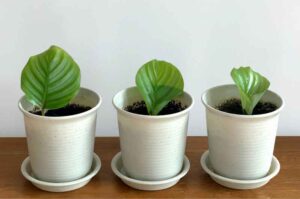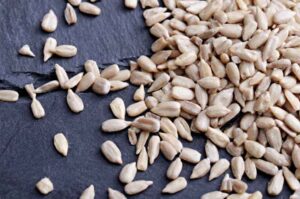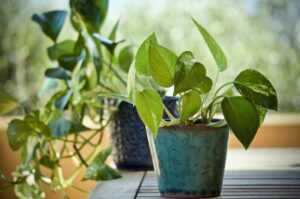Why is My Alocasia frydek Turning Yellow? (8 Easy Fixes)
Alocasia frydek is a subtropical plant native to Eastern Australia and Asia. These plants are very popular as indoor houseplants due to their stunning foliage.
Just like other beautiful houseplants, Alocasia frydek can be a bit challenging to maintain. The plant requires an exact amount of light, water, humidity, etc to show maximum growth.
But to our rescue, these plants do show quite a few signs of distress if something went wrong, and keeping an eye out for these signals is all we need to do.
From such a few distress signals, turning the leaves yellow is one of the most common ones, that people often complain about. In this article, we are going to dig into the problem, and try to answer the question, why is your Alocasia frydek turning yellow.
Here is the answer.
The most common reasons for which an Alocasia frydek is turning yellow are overwatering, underwatering, overexposure to sunlight, lower humidity levels, and temperature stress. Other factors include improper use of fertilizers, poor potting soil, and sometimes pest attack too.
Alocasia frydek being a borderline tropical plant should be provided with a similar surrounding for them to thrive best.
Figuring out the exact problem from the signs of distress and providing the exact solution after that is the key to reviving an Alocasia frydek turning yellow. And that is exactly what we are going to look at today in this article.
So, without any further ado let’s get started with the different causes for yellow leaves in Alocasia frydek and their solutions.
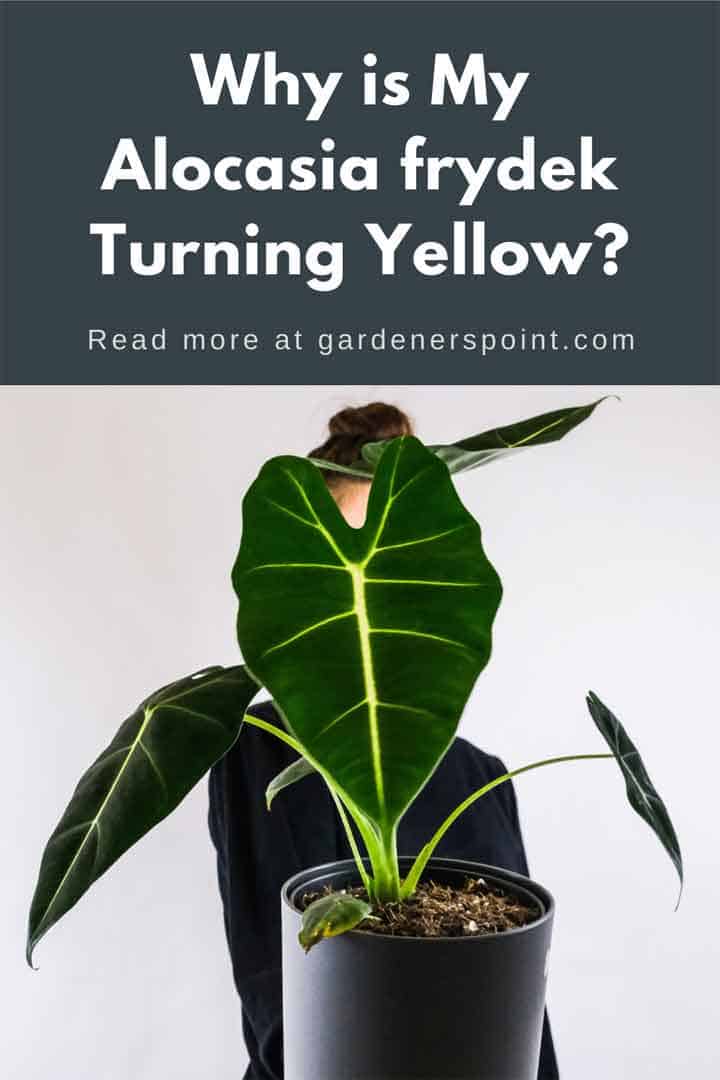
Improper watering habits
It goes without saying that proper watering is a prime requirement for the growth of any houseplant. And Alocasia frydek is in particular quite fussy about their water requirements. This makes it quite a challenging task to figure out how to properly water these plants.
These plants show the best growth in moist soil. This means the soil should neither be soggy with water nor be dry. As such improper watering habits can be a reason why your plant is turning yellow.
Improper watering leads to two conditions that are opposite. One is overwatering and the other is underwatering. Let’s take a look at each one by one.
Overwatering
Overwatering is caused when too much water is present in the soil which is not needed by the plants. This can be caused by many bad practices, major of which are listed down below.
Overwatering causes the soil to get clogged which blocks the air spaces. And as roots also need air to survive, all this does is suffocate them. This leads to root rot and can also cause fungal infections. This manifests itself as the leaves turning yellow and also drooping.
Reasons for Overwatering
- You are keeping your plants in a shady area where it is not getting enough light and thus the soil is staying wet over long durations of time.
- The pot you are using does not have enough drainage holes. Choose a pot that has proper drainage holes to escape out the extra water.
- You are using the wrong potting soil. Well-drained soil is crucial for the development of these plants. Change your potting soil, if it is not draining properly. Or you can also add some perlite or pumice to increase the drainage capacity of your potting soil.
- The size of the pot is not appropriate for the plant. Either it is too big or too small. The soil takes a longer time to dry out and causes sogging if the pot is too big.
Underwatering
Underwatering is the opposite of overwatering. This happens when the soil and consequently the plant does not receive the minimum amount of water it needs for healthy growth. This in turn causes the foliage to lose its charm. So this can also be the cause for your plant’s leaves turning yellow.
The reason for Underwatering can be listed down as follows.
- The plant is kept in bright sunlight that causes the water to evaporate and thus the soil turns dry quicker than it should.
- Irregular watering practices.
- The soil that is being used cannot hold the required amount of water. (Low water holding capacity of the potting soil)
Watering is one of the most essential parts of gardening. Both indoor and outdoors so knowing the correct ways to water these plants is a must.
Solution of watering problems
If you are facing these watering problems then fret not. There are relatively simple ways to start with a proper watering routine again.
- Always check the ground before watering and make sure that you can press the soil at least 1-3 inches deep. This will assure that after watering the plant will not be standing in water for long. If the soil is moist and you can push your finger in then do not water, as the plant is already in moist soil.
- Use a pot with large enough drainage holes that will easily let the excess water pass after watering.
- Place the plant in such a place where it is not too dark and shady, neither in direct sunlight.
- Do not water at a regular fixed time, water only when it is necessary.
On top of this, the water requirement of the plants drops considerably during the winter months. You might notice the plant is growing slowly or the soil is staying wet for longer periods. Switching to “sip watering” is the best option in such cases. Learn the method here,
Overexposure to Sunlight
More often than not, overexposure to sunlight is a bane for indoor foliage plants. And the same goes for Alocasia frydek.
The leaves of these plants cannot tolerate direct sunlight. Direct sunlight causes sunburn on the leaves and makes the plants lose their colors. Making this yet another issue for the yellowing of the plants.
Apart from causing sunburns direct sunlight also causes the leaves to develop brown edges and they end up drooping and the plant loses its beauty. And certainly, you do not want that.
Providing proper lighting conditions is not at all difficult for these plants. The trick is to keep these plants in such a place that has enough light to cast a shadow but the direct rays of the sun do not fall on the plants in any way.
In short, you can say that bright indirect sunlight is best for this plant.
How to get a perfect lighting condition for Alocasia frydek
- Find a place that is getting enough of bright and diffused sunlight.
- Place the plants on the northern window sills as these do not get direct sunlight throughout the day.
- Place curtain or sheer piece of cloth between the plant and the source of sunlight to prevent the rays from falling on the leaves while providing ample light. White cloth or curtains work the best.
You may also like- How to grow green velvet Alocasia frydek – A complete care guide
Temperature stress
Temperature is one of the most crucial deciding factors when it comes to the growth of Alocasia frydek.
These plants grow on the understorey of the tropical forests and thus require a temperature that is around 65 to 85 degrees Fahrenheit. This coincidentally matches the temperature conditions of our homes. But still, you might be facing problems regarding temperature with these plants.
The problem with temperature arises when for some reason the temperature falls below 60 degrees F. Another major issue for the plants is hot and cold air drafts. This can happen when the plant is kept in an area that receives direct air drafts from the air conditioner or an open window.
To fix this issue simply move the plant to a place where there are no chances of such air drafts coming in.
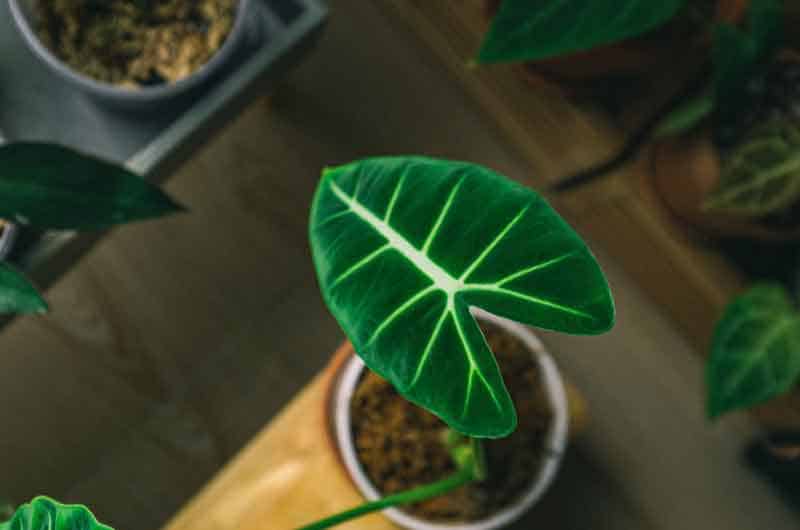
Lower Humidity levels
Lower humidity levels can adversely affect the plants. Alocasia frydek requires humidity levels at least above 50%. Above this level, the plant will show green, healthy leaves and proper growth.
If the humidity level falls below 50% you will start noticing yellow leaves and brown edges on the leaves and the plant on a whole might even start drooping.
An easy instrument to measure the humidity levels in the surrounding air is to use a hygrometer. It will help you to monitor the humidity levels in your house and you can then control it according to your plant’s requirement.
If you notice that the humidity is low in the plant surroundings. You can get them back up using the following methods.
- Use a humidifier. This is the easiest way to get the humidity levels up in the plant surroundings.
- Group the plants. The water released by the plants by transpiration will raise the moisture content in the surrounding air.
- You can also mist the plant from time to time though it is not a permanent solution.
- Use a humidity tray made that can be made using pebbles and a little effort. Click here to learn how to make one https://www.youtube.com/watch?v=YauDIfDXe9A. Or you can buy one online by CLICKING HERE.
Use of Improper Potting soil
Using a proper potting soil mix that has all the qualities required is a must for the healthy growth of your plant. As such, if the potting soil lacks nutrients and other qualities like the ability to hold moisture and drain excess water, your plants will suffer greatly.
It is recommended to use potting soil that is well-drained and can hold moisture as the Alocasia frydek plant, as stated earlier needs moist soil. A mix of 60% peat, 30% perlite, and 10% compost usually does the trick, although you can use other mixtures that have similar properties.
You may also like this article- How to make potting soil for indoor plants
Overfeeding and Underfeeding
Fertilizers should be used very carefully and in certain required amounts and concentrations on these plants. This is because while underfeeding will make sure that the plant does not get enough nutrients, overfeeding comes with its problems. As such both conditions can contribute towards the yellowing of your plants.
Even though Alocasia frydek needs more fertilizing compared to other similar houseplants, they can also fall prey to overfeeding. Overfeeding leaves behind extra unused salts that accumulate on the soil top and becomes visible as white salts. This left behind salts affects the ability of the plants to take up water which further causes dehydration. Drooping, wilting, and yellowing of leaves follow suit.
It is generally advised to use fertilizers that are fast-acting and water-soluble every 3-4 weeks during its growing season. Using organic alternatives is also another great option. The main goal is to provide the plant with enough nitrogen and phosphorus for healthy growth but not overdoing it.
Pest and Diseases
Alocasias are prone to sap-sucking pests. Pests such as spider mites, aphids, mealybugs are the common enemy of this plant.
Checking the leaves of the plants from time to time is a good way to keep an eye on pest growth on the leaves. If you spot any you should attend to it immediately. Different types of pests require different solutions and you can read about the various methods here, https://smartgardenguide.com/common-houseplant-pests/.
As far as diseases are concerned, Alocasia frydek suffers from ailments that are already mentioned such as root rot, caused by overwatering, etc. Thus, addressing those issues will automatically take care of any such diseases that might have overcome your plants.
Final Words
Attending to Alocasias might seem like a hard time-consuming task. But if you are a mindful reader you must have noticed that the emphasis is put on being attentive to your plants’ needs. If you can do this, half of the issues will fall into place.
So, put your detective hat on and look for the cause and apply the required remedy and watch your plants’ leaves turn green again!




